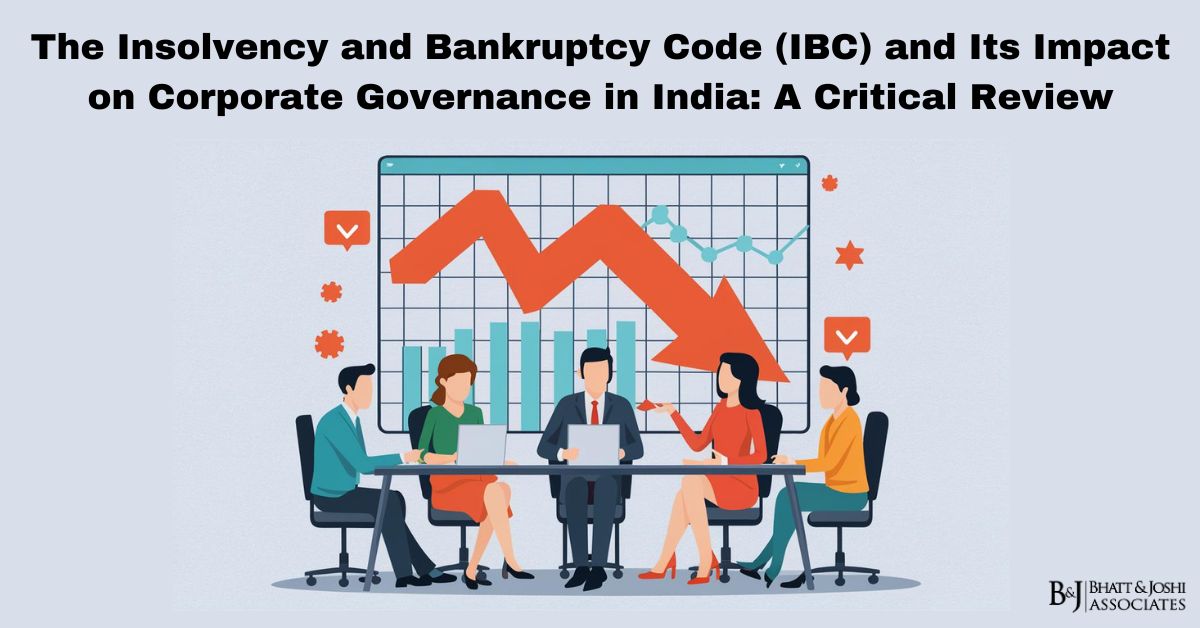Introduction
The Insolvency and Bankruptcy Code (IBC), enacted in 2016, represents a landmark reform in India’s insolvency and bankruptcy landscape. The IBC seeks to consolidate and amend existing laws relating to the reorganization and insolvency resolution of corporate persons, partnership firms, and individuals in a time-bound manner. It aims to improve the ease of doing business, address the issue of non-performing assets (NPAs) in the banking sector, and promote a culture of credit discipline. This comprehensive article examines the impact of the IBC on corporate governance in India, exploring key provisions, significant case laws, and the challenges and future directions of this pivotal legislation.
Introduction to the Insolvency and Bankruptcy Code (IBC)
The IBC was introduced against a backdrop of a fragmented insolvency framework, which included multiple laws and judicial forums, leading to protracted and inefficient insolvency processes. The need for a unified and efficient insolvency law became particularly urgent as India’s economy faced challenges from mounting NPAs in the banking sector. The IBC aims to address these challenges by establishing a clear, transparent, and time-bound insolvency resolution process, thereby improving investor confidence and credit flow in the economy.
Objectives and Key Provisions of the IBC
The primary objectives of the IBC include:
- Consolidation of Insolvency Laws: The IBC consolidates various laws relating to insolvency, previously dispersed across statutes like the Sick Industrial Companies (Special Provisions) Act, 1985, the Companies Act, 1956, and the Recovery of Debts Due to Banks and Financial Institutions Act, 1993. This consolidation aims to create a single, coherent framework for insolvency resolution.
- Time-bound Resolution Process: The IBC mandates a time-bound insolvency resolution process, typically 180 days with a possible extension of 90 days. This time-bound framework aims to resolve insolvencies efficiently, minimizing the erosion of asset value and reducing the time businesses spend in distress.
- Creditor-in-control Mechanism: Under the IBC, the management of the insolvent company is handed over to an Insolvency Resolution Professional (IRP), who operates under the oversight of the Committee of Creditors (CoC). This creditor-in-control model ensures that the interests of creditors are prioritized during the insolvency process.
- Establishment of Adjudicating Authorities: The National Company Law Tribunal (NCLT) and the Debt Recovery Tribunal (DRT) serve as the adjudicating authorities for corporate persons and individuals, respectively. These specialized tribunals streamline the adjudication process for insolvency cases.
- Creation of a New Insolvency Profession: The IBC established a new profession of Insolvency Professionals (IPs), who are responsible for managing the insolvency process, including the running of the debtor’s business and assisting in the preparation of a resolution plan.
- Corporate Insolvency Resolution Process (CIRP): The CIRP is a detailed process initiated upon a default. It involves the IRP assessing the debtor’s financial status, managing the company during the insolvency period, and working with the CoC to find a viable resolution plan.
IBC Impact on Corporate Governance
The IBC has significantly impacted corporate governance practices in India. The impact of the IBC on corporate governance is evident in how it has enhanced accountability, transparency, and creditor rights, prompting notable changes in corporate behavior, particularly concerning financial discipline and management practices.
-
Enhanced Accountability and Transparency
One of the key impacts of the IBC has been the enhancement of accountability and transparency within corporate governance frameworks. The shift from a debtor-in-possession model to a creditor-in-control model ensures that the management of insolvent companies is closely monitored by creditors, represented by the CoC, and overseen by an IRP. This model reduces the potential for mismanagement and malfeasance by company promoters and directors during insolvency proceedings. The requirement for detailed disclosures by the IRP, including the financial state of the company, the resolution process, and the selection of resolution plans, has increased transparency in insolvency proceedings. Additionally, the IBC mandates public announcements of CIRP initiation, providing stakeholders, including employees, creditors, and investors, with timely and accurate information.
-
Strengthening Creditor Rights
The IBC has significantly strengthened the rights of creditors, particularly financial creditors, in the insolvency resolution process. The formation of the CoC, primarily comprising financial creditors, places them at the center of the decision-making process. The CoC is responsible for evaluating and approving resolution plans, thereby ensuring that creditor interests are prioritized. The prioritization of secured creditors in the payment waterfall, as outlined in Section 53 of the IBC, has further strengthened creditor rights. This provision ensures that secured creditors are paid before other stakeholders, including unsecured creditors, employees, and government dues, during the liquidation process. This protection incentivizes lending by providing greater assurance of recovery in case of default.
-
Impact on Promoters and Management
The IBC has fundamentally changed the dynamics between company promoters, management, and creditors. Under the IBC, once the CIRP is initiated, promoters and existing management lose control of the company. The appointment of an IRP, who manages the company’s operations during the resolution process, ensures that decisions are made in the best interest of the creditors. This loss of control has led to a shift in corporate behavior, with promoters and management becoming more conscious of maintaining financial discipline and compliance. The IBC has also introduced provisions to prevent errant promoters from regaining control of their companies through resolution plans, particularly in cases involving fraudulent transactions or wilful default.
-
Reduction in NPA Levels
The IBC has played a crucial role in addressing the problem of NPAs in India’s banking sector. By providing a clear and structured mechanism for insolvency resolution, the IBC has enabled banks to resolve bad loans more effectively. This has led to a cleanup of bank balance sheets, improving financial stability and restoring confidence in the banking sector. The resolution of high-profile cases, such as Essar Steel, Bhushan Steel, and Electrosteel Steels, has highlighted the IBC’s effectiveness in recovering significant amounts of debt. These cases have demonstrated the IBC’s potential to facilitate the restructuring and revitalization of distressed companies, preserving jobs and contributing to economic growth.
-
Encouragement of a Resolution Culture
The IBC has fostered a culture of resolution rather than liquidation. The emphasis on finding viable resolution plans that allow companies to continue operations, rather than liquidating assets, aligns with the broader objective of maximizing the value of the debtor’s assets. This approach encourages stakeholders, including creditors and potential investors, to work collaboratively towards solutions that preserve business value and protect jobs. The emergence of a market for distressed assets, supported by the IBC framework, has attracted significant interest from investors, including private equity firms and strategic buyers. This has led to the development of a more dynamic and competitive market for corporate control, further incentivizing corporate governance improvements.
Significant Case Laws Under the IBC
Several landmark cases under the IBC have shaped its interpretation and implementation, providing clarity on various provisions and principles.
-
Essar Steel India Ltd. vs. Satish Kumar Gupta & Ors. (2019)
The Supreme Court’s judgment in the Essar Steel case was a landmark ruling that clarified the role of the CoC in the resolution process. The Court upheld the primacy of the CoC in deciding on the distribution of proceeds from the resolution plan, emphasizing that the CoC’s commercial wisdom should not be interfered with by adjudicating authorities. This judgment underscored the importance of the creditor-in-control model and reinforced the IBC’s objective of prioritizing creditor interests.
-
Swiss Ribbons Pvt. Ltd. & Anr. vs. Union of India & Ors. (2019)
In the Swiss Ribbons case, the Supreme Court upheld the constitutional validity of various provisions of the IBC, including the classification of financial and operational creditors. The Court acknowledged the unique nature of the IBC as a comprehensive insolvency code and emphasized the importance of speed and efficiency in insolvency resolution. The judgment reinforced the IBC’s framework, highlighting the role of the CoC and the need for a time-bound resolution process.
-
Innoventive Industries Ltd. vs. ICICI Bank & Anr. (2017)
One of the earliest judgments under the IBC, the Innoventive Industries case, provided clarity on the grounds for initiating CIRP. The Supreme Court held that once a default is established, the NCLT must initiate the CIRP, and there is no discretion to consider the merits of the default. This judgment set a precedent for the strict enforcement of the IBC’s provisions, emphasizing the need for a predictable and uniform insolvency process.
-
ArcelorMittal India Private Limited vs. Satish Kumar Gupta & Ors. (2018)
The ArcelorMittal case dealt with the eligibility of bidders under Section 29A of the IBC, which disqualifies certain persons from submitting resolution plans. The Supreme Court ruled that the objective of Section 29A is to ensure that persons responsible for the insolvency of the company do not participate in the resolution process. The judgment highlighted the importance of maintaining the integrity of the insolvency process and ensuring that resolution plans are submitted by eligible and capable bidders.
-
Jaypee Infratech Insolvency Case
The insolvency proceedings against Jaypee Infratech, a major real estate developer, raised significant questions about the treatment of homebuyers under the IBC. The case led to the inclusion of homebuyers as financial creditors, granting them representation in the CoC. This inclusion ensured that the interests of homebuyers were protected during the resolution process, highlighting the IBC’s flexibility and adaptability in addressing emerging issues.
Challenges and Criticisms
Despite its achievements, the IBC faces several challenges and criticisms that need to be addressed to enhance its effectiveness and impact on corporate governance.
-
Delays in Resolution
The IBC’s success depends heavily on its ability to resolve insolvency cases within the stipulated time frame. However, delays have become a significant issue, often caused by judicial backlogs, complex litigation, and appeals. Such delays can erode the value of the debtor’s assets, diminish creditor recoveries, and undermine the effectiveness of the IBC. Addressing these delays is crucial to maintaining the credibility and efficiency of the insolvency resolution process.
-
Capacity Constraints
The NCLT, which serves as the primary adjudicating authority for corporate insolvency cases, faces significant capacity constraints, including a shortage of judges and benches. This has led to delays in case hearings and decisions. Similarly, the limited availability of qualified insolvency professionals has constrained the resolution process, particularly in handling complex and large-scale insolvencies.
-
Concerns About the Role of Insolvency Professionals
While insolvency professionals play a critical role in the IBC framework, concerns have been raised about their conduct and accountability. Instances of potential conflicts of interest, allegations of collusion with certain creditors, and questions about the impartiality of some insolvency professionals have highlighted the need for stricter regulation and oversight.
-
Inconsistencies in Judicial Interpretation
The interpretation of various provisions of the IBC by judicial bodies, including the NCLT, the National Company Law Appellate Tribunal (NCLAT), and the Supreme Court, has sometimes been inconsistent. These inconsistencies can create uncertainty and unpredictability in the resolution process, affecting the confidence of stakeholders and deterring investment in distressed assets.
-
Impact on Small and Medium Enterprises (SMEs)
The IBC’s focus on large corporations and its rigorous procedures may not be well-suited to the needs of SMEs. SMEs often face unique challenges, such as limited access to professional advice and resources, which can hinder their ability to navigate the insolvency process. There is a need for more tailored provisions and support mechanisms to address the specific needs of SMEs.
Reforms and the Way Forward
To address these challenges and enhance the effectiveness of the IBC, several reforms and improvements have been proposed:
-
Strengthening Institutional Capacity
Enhancing the capacity of the NCLT, DRT, and insolvency professionals is crucial to reducing delays and improving the efficiency of the resolution process. This includes increasing the number of benches, appointing more judges, and providing specialized training for insolvency professionals. Additionally, leveraging technology, such as e-courts and digital case management systems, can streamline case handling and reduce backlogs.
-
Improving Regulatory Oversight
Strengthening the regulatory oversight of insolvency professionals and resolution professionals is necessary to ensure their accountability and impartiality. This could involve stricter penalties for misconduct, enhanced monitoring, and clearer guidelines on ethical conduct. The Insolvency and Bankruptcy Board of India (IBBI), the regulator overseeing the insolvency process, plays a key role in this regard and must be empowered to enforce compliance effectively.
-
Clarifying Legal Provisions
To reduce inconsistencies in judicial interpretation, there is a need for clearer legislative provisions and comprehensive guidelines on key aspects of the IBC. This could include standardized protocols for valuation, more explicit definitions of creditor rights, and clearer criteria for resolution plan approval. The government and the IBBI should work together to issue regular updates and clarifications to address emerging issues and concerns.
-
Supporting SMEs
Tailoring the insolvency framework to better address the needs of SMEs is crucial. This could involve simplified insolvency procedures, special provisions for small businesses, and increased access to professional advice and support during the insolvency process. Initiatives such as the pre-packaged insolvency resolution process (Pre-pack) for MSMEs, introduced under the IBC, are a step in this direction and need to be effectively implemented and monitored.
-
Encouraging Alternative Dispute Resolution (ADR)
Promoting the use of ADR mechanisms, such as mediation and arbitration, can help resolve disputes more quickly and amicably, reducing the burden on judicial bodies and expediting the resolution process. ADR mechanisms can be particularly useful in complex insolvency cases involving multiple stakeholders and contentious issues.
Conclusion: Evaluating the Impact of the IBC on Corporate Governance in India
The Insolvency and Bankruptcy Code has been a transformative reform in India’s economic and legal landscape, significantly impacting corporate governance and the broader financial system. While the IBC has achieved substantial progress in improving insolvency resolution and strengthening creditor rights, challenges remain in its implementation. Continued reforms, including capacity building, regulatory strengthening, and legal clarification, are essential to enhance the efficacy of the IBC and ensure it contributes positively to India’s corporate governance framework. As the IBC continues to evolve, it will play a crucial role in shaping the future of corporate governance, financial stability, and economic growth in India.














